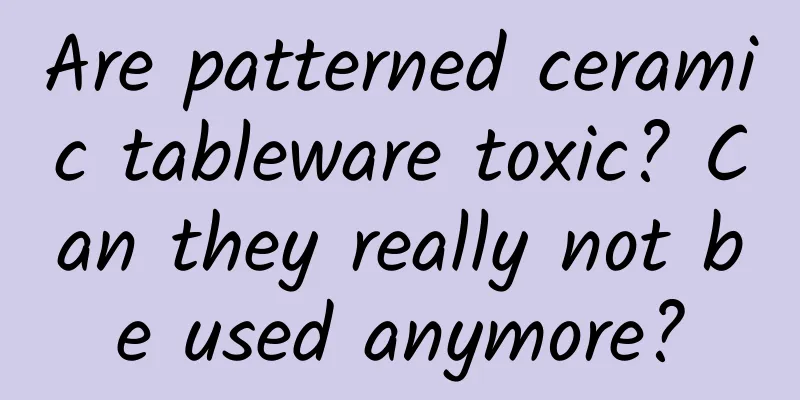Are patterned ceramic tableware toxic? Can they really not be used anymore?

|
"Patterned ceramic tableware is poisonous, don't use it anymore" Recently, some people on the Internet suggested that we should no longer use colored ceramic tableware because they will release a lot of harmful substances during the heating process! Rumor analysis: In fact, this statement is not comprehensive. Safety is of course more important than beauty on the dining table. But this does not mean that beautiful colorful ceramic tableware cannot be used. In fact, as long as it is produced by a regular brand and meets national standards, we can still use it normally. Do you have tableware like this at home? The smooth porcelain surface, with bright colors and delicate patterns, has a special sense of ritual when eating. Copyrighted stock images, reprinting and using may cause copyright disputes But recently, some people on the Internet suggested that we should stop using colored tableware because it may be "toxic"! Is that really the case? Don't use colored ceramic tableware? Just be wary of this one! The ceramic tableware we commonly use in our lives is mainly divided into overglaze color, inglaze color, underglaze color, colored glaze porcelain and white porcelain. The ones we often use with colored pattern decorations are mainly the first three types. The main difference between them is the painting order and firing temperature in the production process. Overglaze is the decoration of the surface of white porcelain fired at high temperature with colored pigments or stickers made of pigments, and then it is fired again at a low temperature of 600-900 degrees Celsius to shape it. In simple terms, it is a structure of embryo-glaze-color. Image source: Reference [2] In-glaze color is achieved by first applying a layer of base glaze on the fired body, then adding a colored decorative layer on the glaze layer, and then applying a layer of warts. Finally, it is fired at a high temperature of 1200~1300 degrees Celsius, which is close to the glaze firing. In this process, the fired pigment will sink into and merge into the glaze layer. After cooling, the glaze layer is sealed to form in-glaze color, which is the structure of body-glaze + color. Image source: Reference [2] Underglaze color, also known as kiln color, is a colored decorative layer painted on the embryo, followed by a glaze layer, and then directly fired at a high temperature of 1200~1300 degrees Celsius in one go, which is the structure of embryo-color-glaze. Image source: Reference [2] Because of the three firing methods, in addition to the different coloring order, the firing temperature of the painted layer can be simply understood as overglaze color < inglaze color < underglaze color. Because the firing temperature of the overglaze painting layer is low and the requirement for the pigment to withstand high temperatures is also low, there is a richer selection of pigment colors, and it can be used to draw decorations with bright colors and complex patterns. Most of the colored porcelain we commonly use is made using this process. Since the pigment layer is in direct contact with food, heavy metal migration may also occur when holding high-temperature food. In the detection of lead and chromium migration of three types of porcelain, the migration of overglaze tableware is higher than that of the other two types. And because the firing temperature is low, the painted layer cannot be integrated with the glaze layer, so the overglaze pattern is prominent on the surface, and it is likely to peel off during long-term friction and erosion, and quietly enter our body. If it is often used to hold hot, acidic food, it will also corrode the pigment and is more likely to aggravate the migration of heavy metals. Therefore, if you have higher requirements for safety, you can give priority to white porcelain or underglaze or inglaze tableware. But this does not mean that beautiful overglaze tableware cannot be used. Although the overall performance of overglaze colors is slightly worse than that of underglaze colors, in-glaze colors and white porcelain - but in fact, as long as it is a qualified product produced by a regular brand and in accordance with national standards, we can still use it normally. However, it should be noted that the implementation standard GB 4806.4-2016 "National Food Safety Standard - Ceramic Products" must be recognized. Since qualified overglaze colored porcelain can also be used, what are the real poisonous tableware? In fact, the low-quality overglaze colored ceramic tableware you buy online/on the street/in scenic spots, these low-quality overglaze colored ceramic tableware with unknown manufacturers and production standards are really poisonous! They have no quality assurance in terms of pigment selection or firing technology. Using them to hold food is a sure way to poison yourself. Don't use them again! If you are not sure what kind of craftsmanship your tableware is made of, but you are reluctant to throw it away, you can make a simple judgment based on the following criteria👇 1. Touch the surface: If it feels rough and has obvious bumps and depressions, it is overglaze color; otherwise, it is underglaze color or underglaze color. 2. Look at the gloss: Look at the surface gloss against the light. If the patterned part has a different light sensation from other parts, it is overglaze color. On the contrary, if the whole part has a uniform glassy gloss, it is underglaze color or underglaze color. 3. Mechanical scratches: If the pattern is damaged by scratching with hard tableware or wire mesh, it is low-quality overglaze. If 1, 2, and 3 all apply, then it is definitely low-quality overglaze paint. Pack it up and throw it away immediately. Don't hesitate! These two "toxic" tableware lurks around many people In fact, in addition to inferior overglaze colored ceramic tableware, there are many other tableware around us that may quietly poison our food without us noticing. 1. Poor quality imitation ceramic tableware Even more toxic than these inferior ceramics is inferior imitation ceramic tableware. The so-called imitation ceramic tableware is actually tableware made of melamine formaldehyde resin. Melamine formaldehyde resin, also known as melamine resin, is produced by the polycondensation reaction of melamine and formaldehyde. Although melamine and formaldehyde are two chemical substances that make us shudder, in fact, this resin is a very excellent material. It has good water resistance, aging resistance, flame retardancy, heat resistance and corrosion resistance. Therefore, imitation porcelain tableware is not only brightly colored, but also extremely light in the hand. More importantly, it is more shatter-resistant than ordinary ceramics - even if you accidentally drop it on the ground, it will only roll in a circle and remain intact. Copyrighted stock images, reprinting and using may cause copyright disputes As a thermosetting plastic, melamine formaldehyde resin can remain relatively stable at 120 degrees Celsius after curing. Generally speaking, melamine tableware is relatively safe when the temperature is below 70°C. Above 70°C, melamine resin decomposes and gradually releases melamine and formaldehyde. As the temperature increases and the contact time increases, the amount of melamine and formaldehyde released increases. Therefore, if you buy inferior products and heat them in a microwave or steam them at high temperature, it may affect the performance of the melamine resin, causing it to decompose, and release a large amount of harmful substances such as formaldehyde and melamine during use, affecting your health. 2. Poor quality colored glass When searching for glass cups on e-commerce platforms, you must have seen this kind of glass cups with beautiful gradient colors. They also have a nice name - glacier cups. Their prices are often not expensive, and some of them are on sale for less than a dollar - this kind of low-quality colored glass cups are usually electroplated, which means that a layer of colored transparent glass coating is applied on the surface of the glass, and then baked at 170~190 degrees Celsius for about 10 minutes to form a thin film. The paint layer and the glass layer are separate, and if the workmanship is not good enough, they will easily peel off. If you use this cup to hold hot water or acidic substances, toxic substances will seep out faster. The heavy metals in the paint quietly dissolve in the water and enter our bodies as we drink cup after cup of water. By the time you realize it, all the paint in the cup has been drunk by you. In summary, whether it is overglaze colored porcelain, imitation ceramic tableware or colored glass, as long as it is produced in strict accordance with national standards and is of qualified quality, it can be used with confidence. However, in daily life, we should try to avoid being greedy for cheapness and convenience. Once we buy unqualified, three-no and inferior products, it may bring huge hidden dangers to our health. Looking in the mirror of rumors When we see some new information online, it is a good thing for consumers to have health awareness. But when we see some sweeping remarks, we should learn to distinguish and avoid over-interpretation. The best way is to find more information and cultivate your own "critical thinking" awareness. Audit丨Cao Wangbei Materials Engineer Zhang Yu, researcher at the Chinese Center for Disease Control and Prevention/PhD, national health science expert |
<<: Sold for over 200,000 RMB, this may be the most expensive hair in the world
>>: Hot search! How to protect babies during the high incidence season of herpetic pharyngitis?
Recommend
Although the nationwide ban has been lifted, you can’t drive randomly!
This article was first published by Hunzhi Financ...
How to avoid glaucoma by playing with your phone before going to bed? Take this scientific "home remedy"
The habit of playing with mobile phone before goi...
Not afraid of strong winds or extreme cold, what technological secrets are hidden in the “flying” Winter Olympics torch?
The flame of the 2022 Beijing Winter Olympics has...
Analysis of new marketing promotion traffic in 2019!
When talking about 2018, the first thing to menti...
How to attract traffic and monetize through WeChat red envelope covers?
Today I want to ask you a few questions, and you ...
Is pomegranate rich in nutrients and can it beautify and fight cancer? Nutrition experts: It is really not recommended for this type of people to eat too much
gossip There are so many seasonal fruits in autum...
Don’t just look at the down content! The new national standard has been implemented. When buying down jackets this year, pay attention to this →
As the weather gets colder, down jackets have bee...
I Have a Horror House free, I Have a Horror House latest chapter list!
A hearse emitting a strange smell stopped at the ...
Flower Pig’s fission activity method!
In the first half of the year, Hua Xiaozhu came o...
For information flow promotion, which channel is currently having the best effect?
2016 is the explosive year for information flow a...
The ears can not only hear sounds, but also "hear" these diseases in your body...
Three days ago, 51-year-old Mr. Li suddenly devel...
Be careful, this kind of rescue "trick" can cost someone's life!
Recently, an enthusiastic reader left a message t...
This realization changed Jobs' life
[[129196]] In 1982, Steve Jobs, then 26, gave a s...
Why does it rain heavily during the Qingming Festival?
Du Mu is the busiest during the Qingming Festival...
The "involution" of the 618 content marketing war
This year's 618 is becoming more and more &qu...









